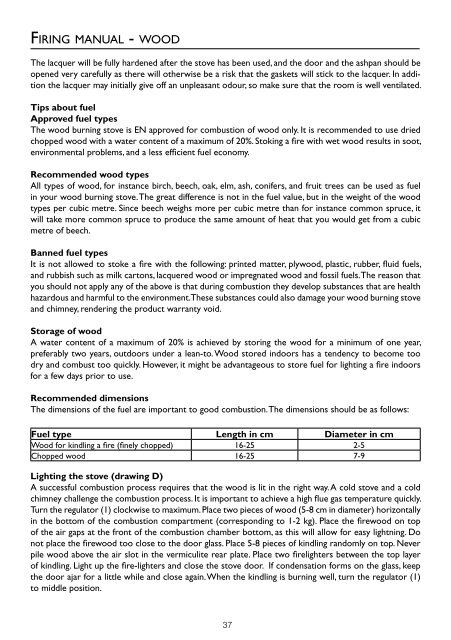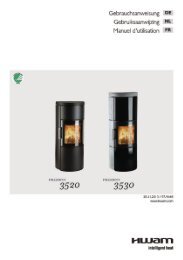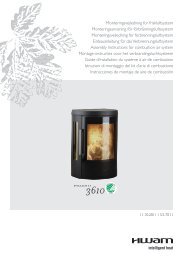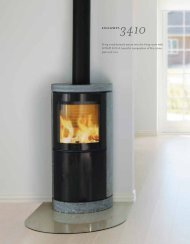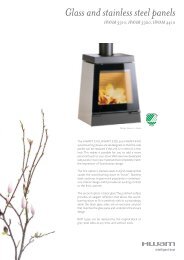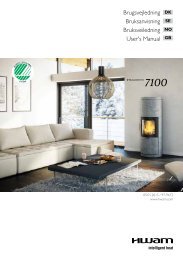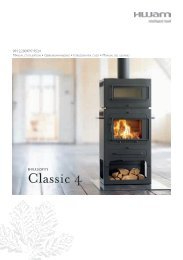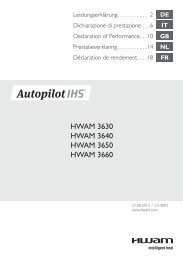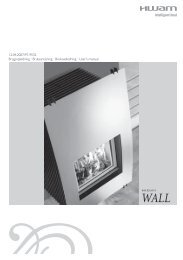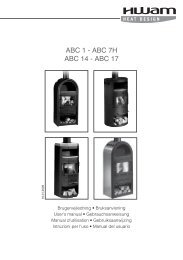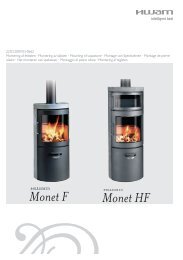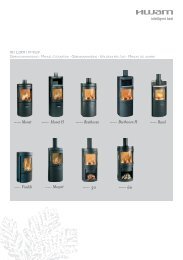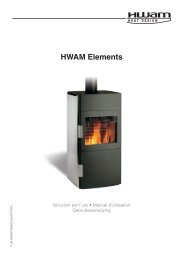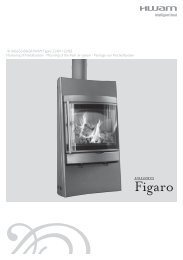prøvningsattest - Hwam
prøvningsattest - Hwam
prøvningsattest - Hwam
Create successful ePaper yourself
Turn your PDF publications into a flip-book with our unique Google optimized e-Paper software.
Firing manual - wood<br />
The lacquer will be fully hardened after the stove has been used, and the door and the ashpan should be<br />
opened very carefully as there will otherwise be a risk that the gaskets will stick to the lacquer. In addition<br />
the lacquer may initially give off an unpleasant odour, so make sure that the room is well ventilated.<br />
Tips about fuel<br />
Approved fuel types<br />
The wood burning stove is EN approved for combustion of wood only. It is recommended to use dried<br />
chopped wood with a water content of a maximum of 20%. Stoking a fire with wet wood results in soot,<br />
environmental problems, and a less efficient fuel economy.<br />
Recommended wood types<br />
All types of wood, for instance birch, beech, oak, elm, ash, conifers, and fruit trees can be used as fuel<br />
in your wood burning stove. The great difference is not in the fuel value, but in the weight of the wood<br />
types per cubic metre. Since beech weighs more per cubic metre than for instance common spruce, it<br />
will take more common spruce to produce the same amount of heat that you would get from a cubic<br />
metre of beech.<br />
Banned fuel types<br />
It is not allowed to stoke a fire with the following: printed matter, plywood, plastic, rubber, fluid fuels,<br />
and rubbish such as milk cartons, lacquered wood or impregnated wood and fossil fuels. The reason that<br />
you should not apply any of the above is that during combustion they develop substances that are health<br />
hazardous and harmful to the environment. These substances could also damage your wood burning stove<br />
and chimney, rendering the product warranty void.<br />
Storage of wood<br />
A water content of a maximum of 20% is achieved by storing the wood for a minimum of one year,<br />
preferably two years, outdoors under a lean-to. Wood stored indoors has a tendency to become too<br />
dry and combust too quickly. However, it might be advantageous to store fuel for lighting a fire indoors<br />
for a few days prior to use.<br />
Recommended dimensions<br />
The dimensions of the fuel are important to good combustion. The dimensions should be as follows:<br />
Fuel type Length in cm Diameter in cm<br />
Wood for kindling a fire (finely chopped) 16-25 2-5<br />
Chopped wood 16-25 7-9<br />
Lighting the stove (drawing D)<br />
A successful combustion process requires that the wood is lit in the right way. A cold stove and a cold<br />
chimney challenge the combustion process. It is important to achieve a high flue gas temperature quickly.<br />
Turn the regulator (1) clockwise to maximum. Place two pieces of wood (5-8 cm in diameter) horizontally<br />
in the bottom of the combustion compartment (corresponding to 1-2 kg). Place the firewood on top<br />
of the air gaps at the front of the combustion chamber bottom, as this will allow for easy lightning. Do<br />
not place the firewood too close to the door glass. Place 5-8 pieces of kindling randomly on top. Never<br />
pile wood above the air slot in the vermiculite rear plate. Place two firelighters between the top layer<br />
of kindling. Light up the fire-lighters and close the stove door. If condensation forms on the glass, keep<br />
the door ajar for a little while and close again. When the kindling is burning well, turn the regulator (1)<br />
to middle position.<br />
37


